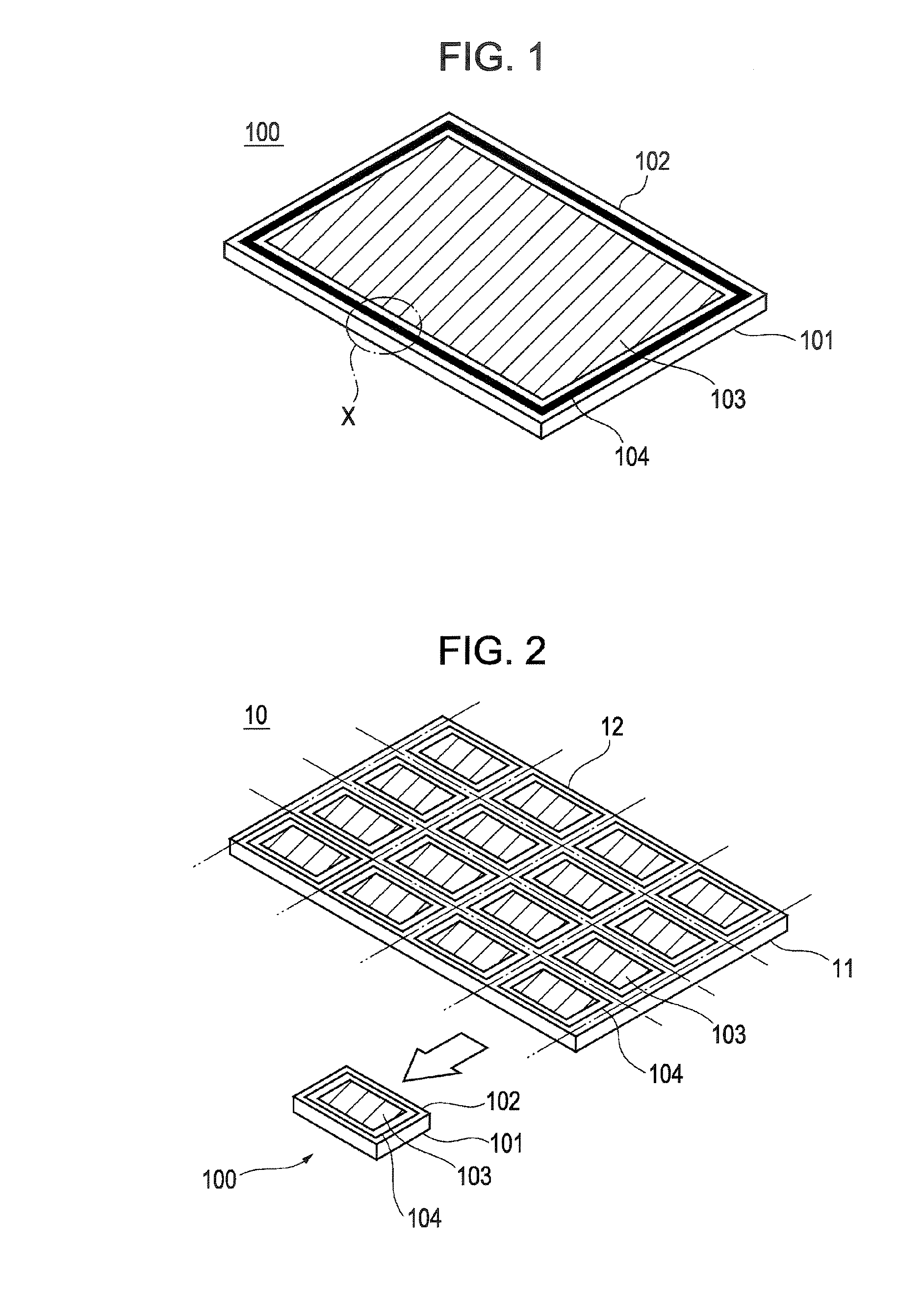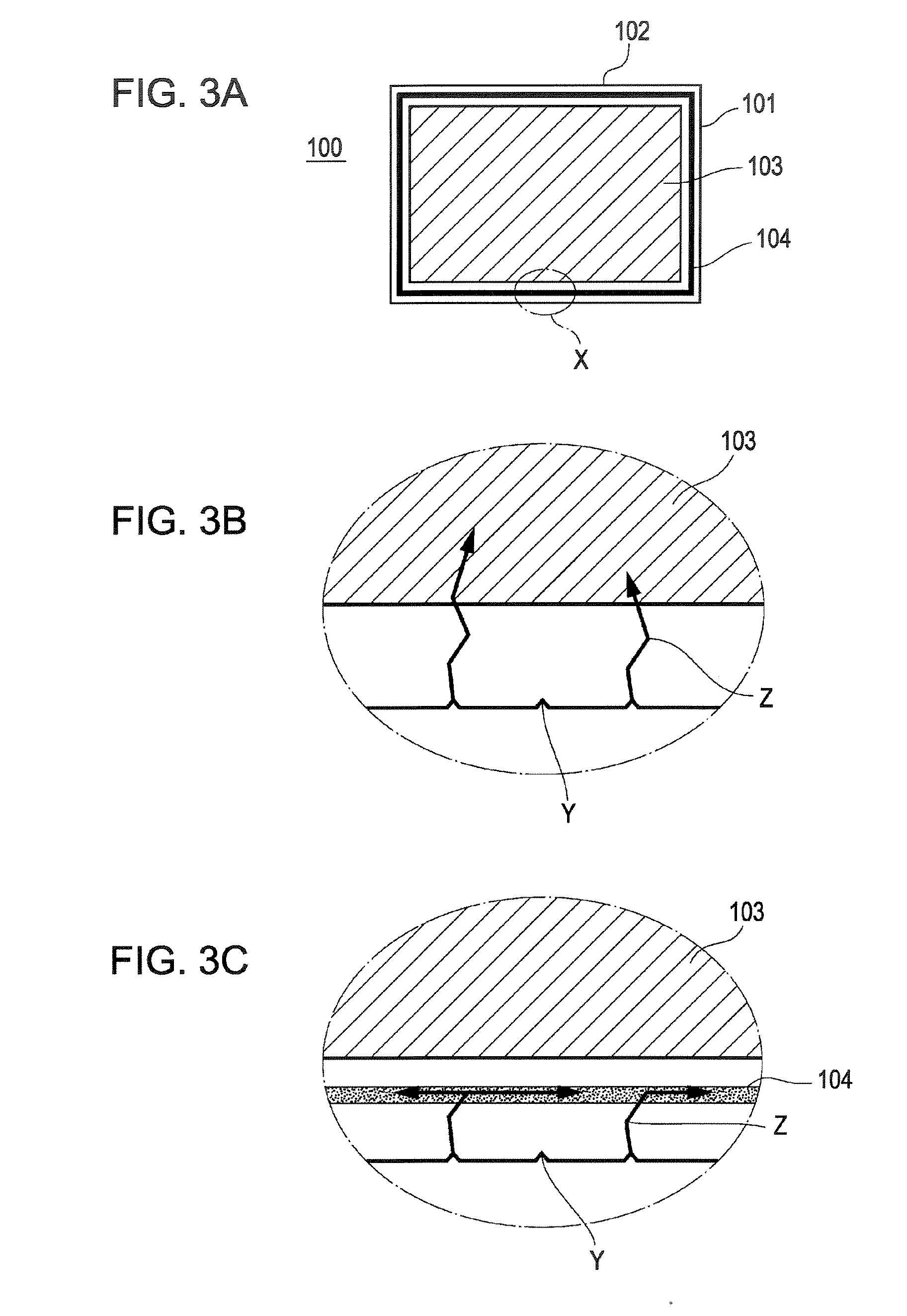Thin-film circuit device, method for manufacturing thin-film circuit device, and electronic apparatus
a technology thin film, which is applied in the direction of sealing/covering of cooking vessels, semiconductor/solid-state device details, cooking vessels, etc., can solve the problems of thermal stress in the substrate, failure and defects of thin film circuit device including a substrate prepared from a resin film, etc., to achieve low cost, reduce manufacturing cost, and low heat resistance
- Summary
- Abstract
- Description
- Claims
- Application Information
AI Technical Summary
Benefits of technology
Problems solved by technology
Method used
Image
Examples
first embodiment
[0047]A thin-film circuit device according to a first embodiment of the present invention will now be described with reference to FIGS. 1 and 2.
[0048]FIG. 1 is a perspective view of the thin-film circuit device. With reference to FIG. 1, the thin-film circuit device is represented by reference numeral 100 and includes a substrate 101 and a thin-film circuit layer 102 disposed thereon. In this embodiment, the thin-film circuit layer 102 has the same size as that of the substrate 101 and is formed on the substrate 101 so as to have an extremely small thickness. The thin-film circuit layer 102 may have a size different from that of the substrate 101.
[0049]The thin-film circuit layer 102 may be directly formed on the substrate 101 or may be formed on another substrate and then joined to the substrate 101 by the above release transfer process using an adhesive.
[0050]The thin-film circuit layer 102 includes an element region 103 and a low-strength region 104 surrounding the element region...
second embodiment
[0070]FIG. 5A shows a thin-film circuit device 100 according to a second embodiment of the present invention. The thin-film circuit device 100, as well as that of the first embodiment, includes a substrate 101 and a thin-film circuit layer 102 including an element region 103 and a low-strength region 104 surrounding the element region 103. The low-strength region 104 has a plurality of grooves.
[0071]FIGS. 5B to 5C are enlarged sectional views of the thin-film circuit device 100, shown in FIG. 5A, taken along the line B-B′.
[0072]The grooves may have a rectangular or inverted trapezoidal shape in cross section as shown in FIG. 5B, a V shape in cross section as shown in FIG. 5C, or a semi-elliptical shape in cross section as shown in FIG. 5D. Alternatively, the grooves may have a semi-circular shape in cross section or may partly have any one of these shapes in cross section.
[0073]According to this configuration, even if cracks are developed in an end portion of the thin-film circuit d...
third embodiment
[0084]A method for manufacturing a thin-film circuit device according to a third embodiment of the present invention will now be described with reference to FIGS. 7A to 7G. In the method, a silicon thin-film for forming planar thin-film transistors is used as an etching stopper in a step of forming grooves having a rectangular shape in cross section.
[0085]As shown in FIG. 7A, a protective layer 201 is formed on a substrate 101 by a CVD process or another process using silicon dioxide or another compound. A silicon layer is formed on the protective layer 201 by a CVD process or another process. The silicon layer is subjected to laser crystallization and then heat treatment, whereby the silicon layer is converted into a polysilicon layer 202.
[0086]As shown in FIG. 7B, the polysilicon layer 202 is patterned, whereby a transistor-forming region and a low-strength region 104 serving as an etching stopper region are formed. Silicon dioxide is deposited over these regions by a CVD process,...
PUM
 Login to View More
Login to View More Abstract
Description
Claims
Application Information
 Login to View More
Login to View More - R&D
- Intellectual Property
- Life Sciences
- Materials
- Tech Scout
- Unparalleled Data Quality
- Higher Quality Content
- 60% Fewer Hallucinations
Browse by: Latest US Patents, China's latest patents, Technical Efficacy Thesaurus, Application Domain, Technology Topic, Popular Technical Reports.
© 2025 PatSnap. All rights reserved.Legal|Privacy policy|Modern Slavery Act Transparency Statement|Sitemap|About US| Contact US: help@patsnap.com



